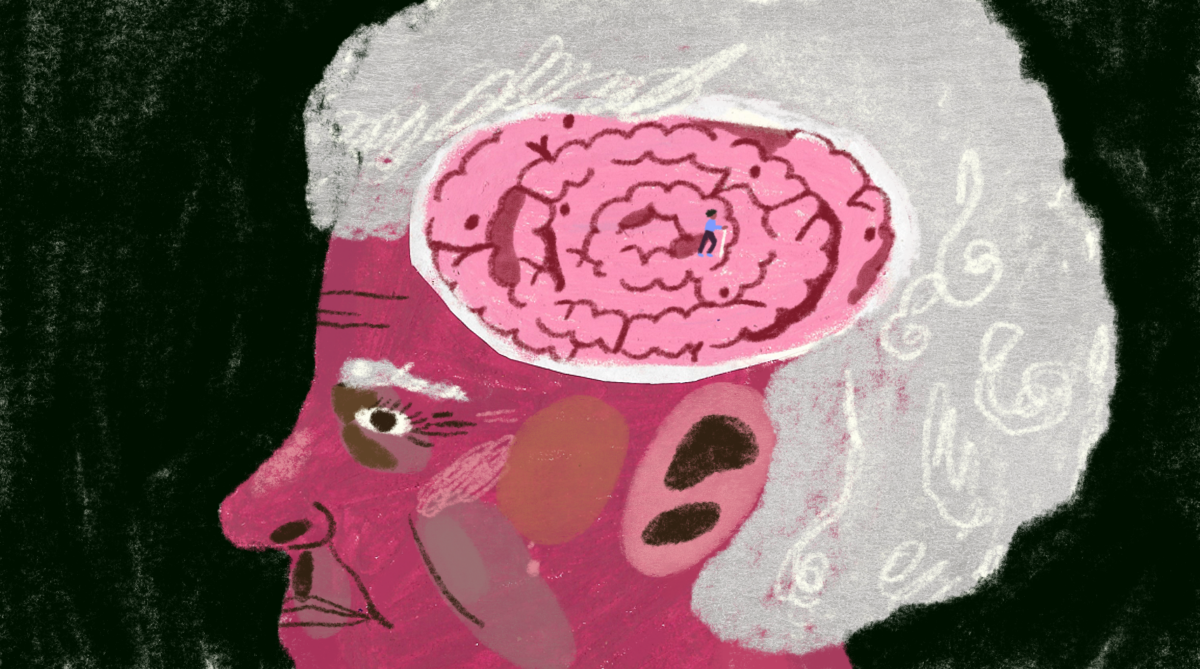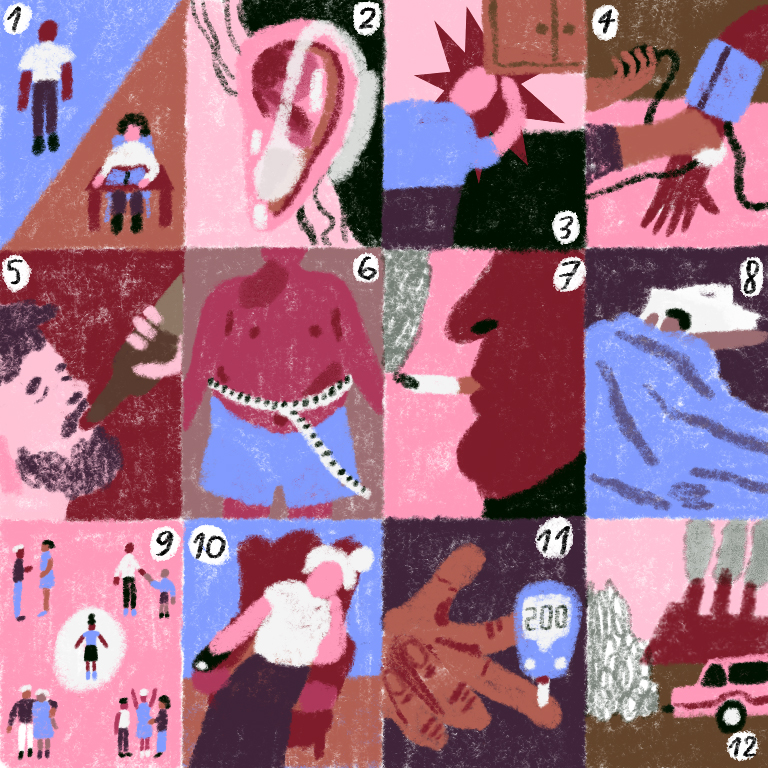 #News
#News
Deaths from Alzheimer’s increase in Brazil, posing a challenge for researchers
The disease is one of the world’s biggest public health issues, especially in low- and middle-income countries, putting a burden on healthcare systems and patients’ families
 Brazil recorded more than 211,000 deaths from complications associated with the disease between 2000 and 2019 | Illustration: Rafaela Pascotto/Estúdio Voador
Brazil recorded more than 211,000 deaths from complications associated with the disease between 2000 and 2019 | Illustration: Rafaela Pascotto/Estúdio Voador
The death rate from Alzheimer’s disease increased significantly in Brazil over the past two decades, a trend that is likely to worsen in the coming years, according to a survey by researchers from the Federal University of São Paulo (UNIFESP) and Columbia University Irving Medical Center, USA.
The team looked at deaths associated with the disease between 2000 and 2019, analyzing them by region, sex, and age group. The data were obtained from the Brazilian public health service’s Mortality Information System (DataSUS). The disease itself is not fatal, but it can worsen other health conditions in affected individuals, ultimately leading to their death.
“People with late-stage Alzheimer’s have difficulty swallowing, which can cause them to involuntarily aspirate small amounts of food,” explains Sérgio Teixeira Ferreira, a biochemist from the Federal University of Rio de Janeiro (UFRJ) who studies the causes of Alzheimer’s. “This food thus ends up in the lungs, where it can cause infections.”
Many have difficulty walking, often suffering falls that lead to serious injuries. To avoid this risk, they may remain in bed or in the same position for long periods of time, which can result in the development of bedsores with the potential to cause fatal infections.
In total, there were more than 211,000 deaths from complications associated with the disease in Brazil between 2000 and 2019. The researchers evaluated the distribution of deaths over time and identified an increase in the mortality rate for all groups analyzed.
The most significant rise was seen in individuals aged 80 and over. In 2001, the death rate from Alzheimer’s among people in this age group was just over 500 per million inhabitants. By 2019, it had jumped to almost 4,000 deaths per million inhabitants.
The study, published in the journal Epidemiologia e Serviços de Saúde, also revealed a sharp increase in the mortality rate among women, especially those aged 80 or over and living in the South, Southeast, and Central-West of Brazil.
The findings are in line with international studies, one of which followed almost 17,000 people in Sweden, finding that women aged 80 and over were more likely than men to be diagnosed with Alzheimer’s. One possible explanation is that women live longer on average.
“One of the main risk factors linked to the development of Alzheimer’s is age, so the older you are, the greater your likelihood of developing the disease,” explains neurologist Paulo Caramelli, a professor from the School of Medicine of the Federal University of Minas Gerais (UFMG). Age is not the only explanation, however.
Caramelli believes the high prevalence of Alzheimer’s among women may be related to a combination of genetic, hormonal, and social factors that are still being studied.
Brazil has also seen an increase in the number of hospital admissions due to the disease.
A study published in the Journal Arquivos de Neuro-Psiquiatria in June 2023 by researchers from the University of Passo Fundo, Rio Grande do Sul, found that the number of hospitalizations for Alzheimer’s rose from 847 in 2010 to 1,212 in 2020, reflected in increased healthcare costs.
In 2010, Alzheimer’s costs totaled just over R$1.8 million. By 2020, this figure had reached approximately R$2.9 million.
Public health problem
Alzheimer’s disease is expected to be one of the world’s biggest public health problems in the coming decades, putting a major burden on healthcare systems and patients’ families. Low- and middle-income countries are expected to be the most affected, especially due to the increasing average age of the global population.

“In France, it took almost 150 years for the percentage of people aged 65 or over to rise from 7% to 14%, whereas in Brazil, this transition is expected to occur within just over two decades,” says Caramelli, who is currently chair of the advisory board to the Alzheimer’s Association International Society to Advance Alzheimer’s Research and Treatment, which connects scientists dedicated to expanding research into Alzheimer’s and other forms of dementia.
He points out that poorer management of risk factors for the disease likely also contributes to the rising number of new cases.
And then there are the socioeconomic issues. “We now know that a lower level of education is a significant risk factor for Alzheimer’s and other types of dementia, because it reduces what we call the brain’s cognitive reserve,” explains the neurologist.
He notes that some studies have highlighted a downward trend in the incidence of Alzheimer’s disease in North America and Europe, which scientists attribute to increased levels of education, better access to treatment, and greater prevention of risk factors. A study published in The Lancet four years ago found that 12 risk factors are linked to 40% of dementia cases worldwide, including Alzheimer’s.
These factors are distributed throughout a person’s life. “In childhood, education reduces the risk, while in middle age, untreated moderate to severe hearing loss is linked to greater risk,” says Caramelli.
“There are also other factors that persist throughout life, such as high blood pressure and cholesterol levels, obesity, diabetes, a sedentary lifestyle, and smoking, which if not prevented or managed can significantly increase a person’s risk of developing the disease,” adds Ferreira, from UFRJ.
Camila Bertini Martins of UNIFESP’s Institute of Science and Technology (ICT), one of the authors of the Epidemiologia e Serviços de Saúde article, sees great potential for preventing the disease in Brazil.
“Access to education, services, and public health policies designed to prevent dementia could change the situation in the country,” says Martins, from UNIFESP.
For the country to prepare and implement the services required to meet the needs of those affected, it is essential to understand the extent of the problem. At this moment, however, the exact incidence of the disease and its mortality in Brazil remains unknown.
“Cases are underreported and most epidemiological studies are carried out in the South and Southeast regions,” says neurologist Sonia Brucki, head of the Cognitive and Behavioral Neurology Group at the Hospital das Clínicas of the University of São Paulo (USP).
Researchers estimate that almost two million people are living with dementia in Brazil, the most common form being Alzheimer’s, which accounts for up to 60% of cases. Many have not been diagnosed, preventing them from receiving adequate treatment that would help control the changes in memory, reasoning, mood, and behavior that occur as the disease progresses.
Caramelli believes the lack of diagnoses is partly associated with a shortage of healthcare professionals trained to identify the initial symptoms of the disease in primary care. “Another problem is the public’s lack of knowledge, with memory loss largely seen as a normal sign of aging, which is not always true,” points out Brucki.
“We need to educate people and train doctors and other professionals in the public healthcare system—especially general practitioners, who are often the first point of contact with the patient—to recognize symptoms, use diagnostic tools, and order exams to identify the disease as early as possible.”
Treatment strategies
Alzheimer’s is a progressive neurodegenerative disease caused by a buildup of two proteins in the brain: beta-amyloid and tau. The first symptoms—failure to remember recent events—appear more frequently after the age of 65.
“Some studies, however, indicate that the disease can begin to develop in the brain up to two decades earlier,” says Ferreira.
There is no cure for the disease, but there are drugs available in the public health system that can alleviate the symptoms, such as memory loss. Cholinesterase inhibitors—donepezil, galantamine, and rivastigmine—are indicated for mild and moderate cases. They increase the availability of acetylcholine in the brain, a neurotransmitter that plays an important role in cognition.
“Observational studies suggest that in the long term, these medications can slow down the progression of symptoms and reduce mortality,” explains Caramelli.

At more advanced stages, the preferred option is memantine. The drug modulates the action of another neurotransmitter called glutamate, which in high concentrations is toxic to neurons.
In addition to being expensive, these medications have modest results, only moderately reducing the rate of cognitive decline. “The patient’s condition continues to worsen, but more slowly,” says Ferreira.
In July 2022, American pharmaceutical company Eli Lilly announced the results of the final phase of clinical trials of an experimental drug developed to treat the disease. The medication, a monoclonal antibody called donanemab, proved capable of delaying cognitive decline by up to 60% in individuals treated in the early stages of the disease.
Eli Lilly released preliminary results of its trial two months earlier, but some experts remained skeptical about the drug’s safety and effectiveness in certain patient groups.
The announcement about the new medication came just weeks after the US Food and Drug Administration (FDA) approved another drug for use against the disease: lecanemab, made by Japanese pharmaceutical company Eisai.
A third drug, aducanumab, was approved in 2021 but will be discontinued at the end of this year. All three use the same mechanism of eliminating beta-amyloid clumps in the brain.
Obstacles and optimism
The approval of these drugs marks a turning point in what has been a long and arduous path to delaying Alzheimer’s, a “complex, challenging disease whose biological actions are not yet fully known, which makes everything much more difficult,” says Ferreira.
The downside to these medications is that in addition to being expensive, they can cause a problem known as amyloid-related imaging abnormalities (ARIA), which occasionally leads to convulsions and brain hemorrhages.
Roughly a quarter of the participants in Eli Lilly’s phase 3 trial developed ARIA, and three of them died as a result. Cases of ARIA were more common in participants with the APOE4 genetic variant, which increases the risk of developing Alzheimer’s. Individuals with the APOE4 variant also benefited less from donanemab compared to participants without the gene.
Despite these obstacles, Caramelli is optimistic. “It is only a matter of time before new medications emerge,” he says.
“We may still be a long way off finding a cure, but medicines that help manage symptoms and slow down progression… I believe this is something we will achieve in the medium term.”
Prevention, by managing the identified risk factors, is still the best strategy for preventing the disease, says Caramelli, especially because it offers the chance to respond to various disease mechanisms that can cause dementia and to integrate measures into public health programs that can reach more people.
*
This article may be republished online under the CC-BY-NC-ND Creative Commons license.
The text must not be edited and the author(s) and source (Science Arena) must be credited.
News
 #News
#News
 #News
#News
 #News
#News
